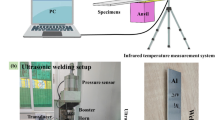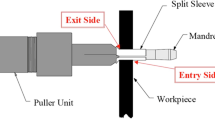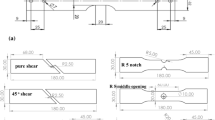Abstract
The current research aims in evaluating the 3D temperature distribution of the friction stir–welded plates of AA1100 alloy by using a 9-point finite difference method (FDM). The isotherms, surface plots, and temperature profiles have been obtained from the FDM to analyse the distribution of temperature and compare them with the experimental results. Microstructure analysis, residual stress distribution, and tensile test have been conducted to determine the joint quality that strongly depends on the amount of heat generation which again is governed by the processing parameters. All the weld specimens exhibited an increase in tensile strength by 20% than that of the base metal. The microstructural study clearly indicates the grain refinement in the weld nugget. Residual stress measurement of the weld showed compressive nature of the stress in the joint and tensile nature below the tool shoulder region. This welding process finds various applications in the automotive industries as the need for better structural performance in the joining components of several vehicles and ship building parts is highly expected.
















Similar content being viewed by others
References
Threadgill PL, Leonard AJ, Shercliff HR, Withers PJ (2009) Friction stir welding of aluminium alloys. Int Mater Rev 54:49–93
Mishra RS, Ma ZY (2005) Friction stir welding and processing. Mater Sci Eng R Rep 50(1–2):1–78
Nandan R, Debroy T, Bhadeshia HKDH (2008) Recent advances in friction-stir welding – Process, weldment structure and properties. Prog Mater Sci 53:980–1023
He X, Gu F, Ball A (2014) A review of numerical analysis of friction stir welding. Prog Mater Sci 65:1–66
Tikader S, Biswas P, Puri AB (2016) A Study on Tooling and Its Effect on Heat Generation and Mechanical Properties of Welded Joints in Friction Stir Welding. J Inst Eng India Ser C 99(3). https://doi.org/10.1007/s40032-016-0325-y
Soundararajan V, Zekovic S, Kovacevic R (2005) Thermo-mechanical model with adaptive boundary conditions for friction stir welding of Al 6061. Int J Mach Tools Manuf 45:1577–1587
Assidi M, Fourment L, Guerdoux S, Nelson T (2010) Friction model for friction stir welding process simulation: Calibrations from welding experiments. Int J Mach Tools Manuf 50:143–155
Cui S, Chen ZW, Robson JD (2010) A model relating tool torque and its associated power and specific energy to rotation and forward speeds during friction stir welding/processing. Int J Mach Tools Manuf 50:1023–1030
Barnes T, Pashby I (2000) Joining techniques for aluminium spaceframes used in automobiles. J Mater Process Technol 99:62–71
Flint TF, Francis JA, Smith MC (2019) A semi-analytical solution for the transient temperature field generated by a volumetric heat source developed for the simulation of friction stir welding. Int J Thermal Sci 138:586–595
Essa ARS, Ahmed MMZ, Ahmed Mohamed AKY, El-Nikhaily AE (2016) An analytical model of heat generation for eccentric cylindrical pin in friction stir welding. J Mater Res Technol 5:234–240
Salimi S, Bahemmat P, Haghpanahi M (2014) A 3D transient analytical solution to the temperature field during dissimilar welding processes. Int J Mech Sci 79:66–74
Haghpanahi M, Salimi S, Bahemmat P, Sima S (2013) 3-D transient analytical solution based on Green’s function to temperature field in friction stir welding. Appl Math Model 37:9865–9884
Zhang B, Chen X, Pan K, Li M, Wang J (2019) Thermo-mechanical simulation using microstructure-based modeling of friction stir spot welded AA 6061-T6. J Manuf Process 37:71–81
Robe H, Claudin C, Bergheau JM, Feulvarch E (2019) R-ALE simulation of heat transfer during friction stir welding of an AA2xxx/AA7xxx joint on a large process window. Int J Mech Sci 155:31–40
Bagheri B, Abbasi M, Givi M (2019) Effects of Vibration on Microstructure and Thermal Properties of Friction Stir Spot Welded (FSSW) Aluminum Alloy (Al5083). Int J Precis Eng Manuf 20:1219–1227
Li H, Gao J, Li Q, Galloway A, Toumpis A (2018) Sci Technol Weld Join 24:156
Shi L, Wu CS (2017) Transient model of heat transfer and material flow at different stages of friction stir welding process. J Manuf Process 25:323–339
Villegas JF, Dominguez JV, Ochoa GV, Unfried-Silgado J (2017) Thermo-mechanical modeling of friction-stir welding tool used in aluminum alloys joints. Contemp Eng Sci 10:1659–1667
Dialami N, Chiumenti M, Cervera M, Segatori A, Osikowicz W (2017) Enhanced friction model for Friction Stir Welding (FSW) analysis: Simulation and experimental validation. Int J Mech Sci 133:555–567
Xiao Y, Zhan H, Gu Y, Li Q (2017) Modeling heat transfer during friction stir welding using a meshless particle method. Int J Heat Mass Transf 104:288–300
Zhang Z, Tan ZJ (2019) A Multi Scale Strategy for Simulation of Microstructural Evolutions in Friction Stir Welding of Duplex Titanium Alloy. High Temp Mater Proc 38:485–497
Fraser KA, St-Georges L, Kiss LI (2014) Optimization of Friction Stir Welding Tool Advance Speed via Monte-Carlo Simulation of the Friction Stir Welding Process. Mater 7:3435–3452
Kadri M (1983) Analysis of the nine-point finite difference approximation for the heat conduction equation in a nuclear fuel element, PhD Thesis, Iowa State University, Ames, Iowa
Cheney W, Kincaid D Numerical mathematics and Computing, 6th edn. Brooks/Cole Publishing Company, California
Rohach AF (1973) Nine-point difference approximation to Laplacian operator. Trans Am Nucl Soc 17:232–233
Bayazida SM, Farhangia H, Ghahramani A (2015) Effect of Pin Profile on Defects of Friction Stir Welded 7075 Aluminum Alloy. Procedia Mater Sci 11:12–16
Senapati NP, Bhoi RK (2020) Grain Size Optimization Using PSO Technique for Maximum Tensile Strength of Friction Stir-Welded Joints of AA1100 Aluminium. Arab J Sci Eng 45:5647–5656
Senapati NP, Bhoi RK (2021) Improving the Strength of Friction-Stir-Welded Joints of AA1100 Alloy. J Mater Eng Perform 30:510–521
Van Houtte P, De Buyser L (1993) The Influence of Crystallographic Texture on Diffraction Measurements of Residual Stress. Aeta metal mater 41(2):323–336
Yan F, Zhang Y, Fu X, Li Q, Gao J (2019) A new calculating method of frictional heat and its application during friction stir welding. Appl Thermal Eng 153:250–263
Patil S, Tay YY, Baratzadeh F, Lankarani H, Mech J (2018) Sci Technol 32:2569–2575
Yaduwanshi DK, Bag S, Pal S (2014) Heat transfer analyses in friction stir welding of aluminium alloy. Proc IMechE Part B: J Engineering Manufacture 229(10):1722–1733
M. Zamani, Al-Si cast alloys-microstructure and mechanical properties at ambient and elevated temperature, Licentiate Thesis, Department of Materials and Manufacturing, School of Engineering, Jönköping University, Jönköping, Sweden, 3-15 (2015)
Verma S, Meenu G, Misra JP (2017) Study on temperature distribution during Friction Stir Welding of 6082 aluminum alloy, 5th Int Conf Mater Process Charac (ICMPC 2016). Mater Today: Proceed 4:1350–1356
Aval HJ, Serajzadeh S, Kokabi AH (2012) Experimental and theoretical evaluations of thermal histories and residual stresses in dissimilar friction stir welding of AA5086-AA6061. Int J Adv Manuf Technol 61:149–160
Ghetiya ND, Patel KM, Patel AB (2015) Prediction of temperature at weldline in air and immersed friction stir welding and its experimental validation. Int J Adv Manuf Technol 79:1239–1246
Sheikh-Ahmad JY, Ozturk F, Jarrar F, Evis Z (2016) Thermal history and microstructure during friction stir welding of Al–Mg alloy. Int J Adv Manuf Technol 86:1071–1081
Liu HJ, Fujii H, Maeda M, Nogi K (2003) Mechanical properties of friction stir welded joints of 1050 – H24 aluminium alloy. Sci Technol Weld Join 8:450–454
Wang FF, Li WY, Shen J, Hu SY, Santos J (2015) Effect of tool rotational speed on the microstructure and mechanical properties of bobbin tool friction stir welding of Al–Li alloy. Mater Des 86:933–940
Hu ZL, Wang XS, Yuan SJ (2012) Quantitative investigation of the tensile plastic deformation characteristic and microstructure for friction stir welded 2024 aluminum alloy. Mater Charact 73:114–123
Peel MJ, Steuwer A, Withers PJ, Dickerson T, Shi Q, Shercliff H (2006) Dissimilar friction stir welds in AA5083-AA6082. Part I: Process parameter effects on thermal history and weld properties. Metall Mater Trans A 37:2183–2193
Steuwer A, Peel MJ, Withers PJ (2006) Dissimilar friction stir welds in AA5083–AA6082: The effect of process parameters on residual stress. Mater Sci Eng A 441:187–196
Chen Z, Li S, Hihara LH, Microstructure, mechanical properties and corrosion of friction stir welded 6061 Aluminium alloy, Hawaii Corrosion Laboratory, University of Hawaii at Manoa, Honolulu, HI 96822, USA
Liu HJ, Hou JC, Guo H (2013) Effect of welding speed on microstructure and mechanical properties of self-reacting friction stir welded 6061-T6 aluminum alloy. Mater Des 50:872–878
Ma ZY, Mishra RS, Mahoney MW (2002) Superplastic deformation behaviour of friction stir processed 7075Al alloy. Acta Mater 50:4419–4430
Su JQ, Nelson TW, Mishra R, Mahoney M (2003) Microstructural investigation of friction stir welded 7050- T651 aluminium, Acta Mater 5:713–729
Hamilton C, Dymek S, Blicharski M (2008) A model of material flow during friction stir welding. Mater Charact 59:1206–1214
Sutton MA, Yang B, Reynolds AP, Taylor R (2002) Microstructural studies of friction stir welds in 2024-T3 aluminum. Mater Sci Eng A 323:160–166
Author information
Authors and Affiliations
Corresponding author
Ethics declarations
Conflict of interest
The authors declare no competing interests.
Additional information
Publisher’s note
Springer Nature remains neutral with regard to jurisdictional claims in published maps and institutional affiliations.
Recommended for publication by Commission III - Resistance Welding, Solid-State Welding, and Allied Joining Process
Rights and permissions
About this article
Cite this article
Senapati, N.P., Bhoi, R.K. Numerical simulation of temperature distribution by 9-point finite difference scheme to study the weld properties of AA1100 friction stir–welded joints. Weld World 65, 1501–1517 (2021). https://doi.org/10.1007/s40194-021-01142-y
Received:
Accepted:
Published:
Issue Date:
DOI: https://doi.org/10.1007/s40194-021-01142-y




